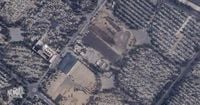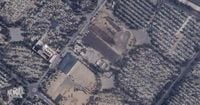On the outskirts of Tehran, where the city’s noise gives way to a sprawling landscape of headstones and mausoleums, a quiet but profound transformation is underway. Lot 41 of Behesht-e Zahra, the largest cemetery in Iran’s capital, is being paved over to become a parking lot. This unassuming patch of sand and scrawny trees has, for decades, been known as the final resting place for thousands executed in the turbulent aftermath of the 1979 Islamic Revolution. Now, as construction vehicles roll in and asphalt covers the earth, the fate of those buried beneath—and the memory of the events that placed them there—hangs in the balance.
Satellite images from Planet Labs PBC, analyzed by multiple news outlets including ABC, Associated Press, and Shargh, confirm that work on the site began in early August 2025. By August 18, roughly half of Lot 41 had already been paved, with trucks and piles of asphalt still visible, indicating the project was far from complete. Iranian officials publicly acknowledged the plan in early September, with Tehran’s deputy mayor Davood Goudarzi and cemetery manager Mohammad Javad Tajik confirming the development on state television and in the press.
“In this place, hypocrites of the early days of the revolution were buried and it has remained without change for years,” Goudarzi told journalists, as quoted by AP. “We proposed that the authorities reorganize the space. Since we needed a parking lot, the permission for the preparation of the space was received. The job is ongoing in a precise and smart way.”
The new parking area is intended to serve visitors to a neighboring section of the cemetery, where authorities plan to bury those killed in the Iran–Israel conflict that erupted in June 2025. That brief but deadly war saw a major Israeli airstrike campaign, resulting in more than 1,060 deaths according to official government figures, and over 1,190 according to activist groups. The decision to repurpose Lot 41, however, has ignited controversy far beyond the question of parking logistics.
Lot 41, sometimes referred to as the “scorched section,” has long been under state surveillance. Cameras and patrols have monitored the area for any signs of dissent or acts of remembrance. Over the years, grave markers have been vandalized, trees deliberately dried out, and the area subjected to repeated acts of destruction. The site’s notoriety stems from its history: research by Shahin Nasiri, a lecturer at the University of Amsterdam, estimates that between 5,000 and 7,000 people—including communists, monarchists, militants, and others deemed “religious outlaws” by the state—are buried there. Many were executed at gunpoint or by hanging during the revolution’s chaotic early days, their bodies rapidly interred without ceremony or record.
“Most of the graves and gravestones of dissidents were desecrated, and the trees in the section were deliberately dried out,” Nasiri explained to AP. “The decision to convert this section into a parking lot fits into this broader pattern and represents the final phase of the destruction process.”
The controversy is not merely symbolic. Iranian cemetery regulations require that land used for burials can only be repurposed more than 30 years after interments, and only with the consent of the families of the deceased. In the case of Lot 41, it remains unclear whether such consent was ever sought or obtained. Outspoken lawyer Mohsen Borhani criticized the move in Shargh, stating, “The piece was not only for executed and political people. Ordinary people were buried there, too.” He went on to call the decision neither moral nor legal, highlighting the lack of transparency and due process.
The fate of the human remains themselves is equally uncertain. No evidence has emerged to suggest that bodies were exhumed prior to paving; indeed, Iran has a history of demolishing burial grounds without removing the remains. This was the case with the mass graves of victims from the 1988 executions, as well as with cemeteries belonging to the Baha’i religious minority and burial sites of protesters killed in the 2009 Green Movement and the 2022 Mahsa Amini demonstrations. “Impunity for atrocities and crimes against humanity has been building for decades in the Islamic Republic,” Hadi Ghaemi, executive director of the New York-based Centre for Human Rights in Iran, told AP. “There is a direct line between the massacres of the 1980s, the gunning down of demonstrators in 2009, and the mass killings of protesters in 2019 and 2022.”
The United Nations has also voiced concern. In 2024, a special rapporteur accused Tehran of systematically destroying graveyards to “conceal or erase data that could serve as potential evidence to avoid legal accountability” for past actions. The deliberate erasure of burial sites, critics argue, is an attempt to rewrite history and stymie efforts to seek justice for the victims and their families.
Behesht-e Zahra itself is no ordinary cemetery. Opened in 1970 to relieve pressure on Tehran’s crowded burial grounds, it quickly became a landmark in the city’s history. Upon his return from exile in 1979, Grand Ayatollah Ruhollah Khomeini visited Behesht-e Zahra, where many killed in the uprising against the shah were buried. Following his death in 1989, Iran built a golden-domed mausoleum for Khomeini adjoining the cemetery, further cementing its place in the nation’s collective memory.
As the city expanded, so did Behesht-e Zahra, and Lot 41 found itself encircled by new burial sections. Yet, despite its unmarked appearance and official neglect, the lot has remained a site of pilgrimage for survivors and family members seeking the graves of their loved ones. “Many survivors and family members of the victims are still searching for the graves of their loved ones,” Nasiri said. “They seek justice and aim to hold the perpetrators accountable. The deliberate destruction of these burial sites adds an additional obstacle to efforts of truth-finding and the pursuit of historical justice.”
The transformation of Lot 41 into a parking lot is not just a matter of urban planning. It is a stark reminder of the unresolved wounds of Iran’s revolutionary past, and the ongoing struggle over how that history is remembered—or erased. As the asphalt hardens and the past is literally paved over, the questions of justice, memory, and accountability remain as pressing as ever for those left behind.






